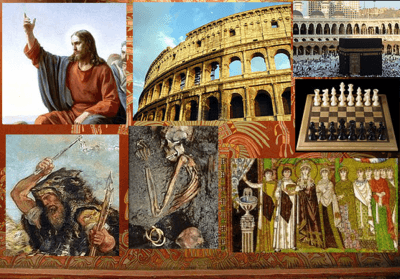1st millennium facts for kids

| Millennia: | 1st millennium BC · 1st millennium AD · 2nd millennium AD |
| Centuries: | 1st century · 2nd century · 3rd century · 4th century · 5th century · 6th century · 7th century · 8th century · 9th century · 10th century |
The first millennium was a period of 1,000 years. It started in the year 1 CE (Common Era) and ended in the year 1000 CE. This time included the 1st through the 10th centuries. During this millennium, the world population grew from about 200 million people to around 300 million. This was a slower growth rate than in the 1,000 years before.
Contents
Europe and the Near East
This millennium was a time of big changes in Europe and the Near East. It marked the shift from Classical Antiquity to the Middle Ages. Classical Antiquity refers to the time of ancient Greece and Rome. The Middle Ages came after the fall of the Roman Empire.
The Roman Empire and New Religions
In the 1st century, the Roman Empire was at its strongest. But after this, it slowly started to decline. This period is sometimes called Late Antiquity. During this time, Christianity began to spread widely. Many different groups of people also moved across Europe. These movements are known as the Great Migrations.
The second half of the millennium is known as the Early Middle Ages in Europe. This era saw the rise of the Byzantine Empire in the east. The Vikings also expanded their reach in the west. They sailed and raided across many parts of Europe.
The Rise of Islam
Islam started in the Arabian Peninsula and grew very quickly. It spread across western Asia, India, North Africa, and the Iberian Peninsula (modern-day Spain and Portugal). This expansion led to the Islamic Golden Age. This was a time of great learning and new ideas, lasting from about 700 to 1200 CE.
Asia's Cultural Growth
In East Asia, the first millennium was a time of major cultural progress. One important event was the spread of Buddhism across the region.
China's Dynasties
In China, the Han dynasty ended. It was replaced by the Jin dynasty. Later, the powerful Tang dynasty ruled for a long time. By the 10th century, China became divided again. This period is called the Five Dynasties and Ten Kingdoms period.
Japan and India
In Japan, the population grew a lot. Farmers started using iron tools, which helped them grow more crops. The Yamato court was also formed. This was an important ruling family.
The Indian subcontinent was home to many different kingdoms throughout this millennium. Eventually, the Gupta Empire was formed. This empire brought a period of peace and prosperity to India.
The Americas and Africa
The first millennium also saw important developments in the Americas and Africa.
Mesoamerica and South America
In Mesoamerica, this period was a time of huge growth. It is known as the Classic Era (200–900 CE). The city of Teotihuacan became a very large city. Its empire controlled much of Mesoamerica.
In South America, cultures like the Moche and Nazca thrived along the coast. These groups created amazing metalwork and some of the best pottery from the ancient world.
North America and Sub-Saharan Africa
In North America, the Mississippian culture began to rise towards the end of the millennium. This culture developed in the Mississippi and Ohio river valleys. They built many cities, with Cahokia in present-day Illinois being the largest. Construction of Monks Mound at Cahokia started around 900–950 CE.
In Sub-Saharan Africa, the Bantu expansion continued. Bantu-speaking people reached Southern Africa by about the 5th century. By the 9th century, the Arab slave trade was active across the Sahara desert and along the Swahili coast.
Images for kids
See also
 In Spanish: I milenio para niños
In Spanish: I milenio para niños


